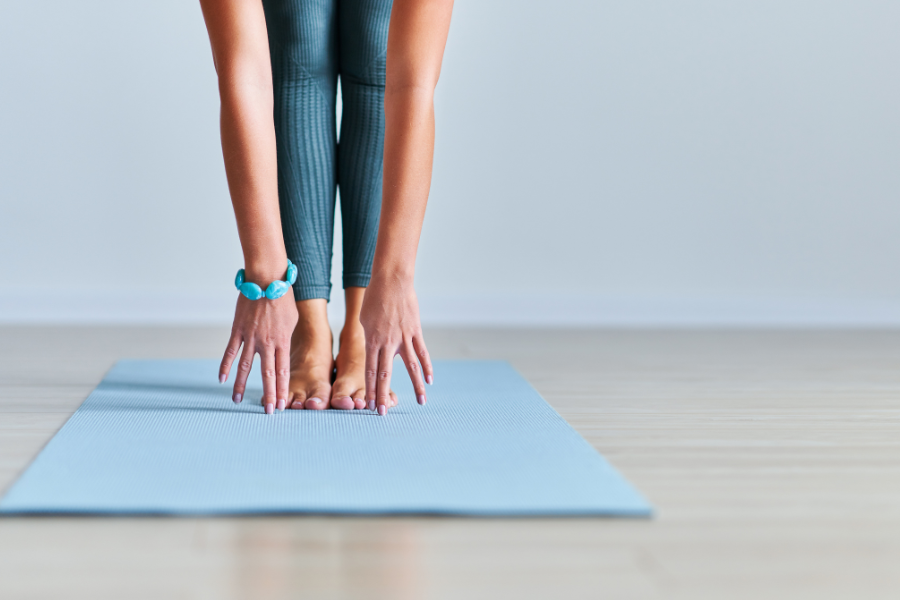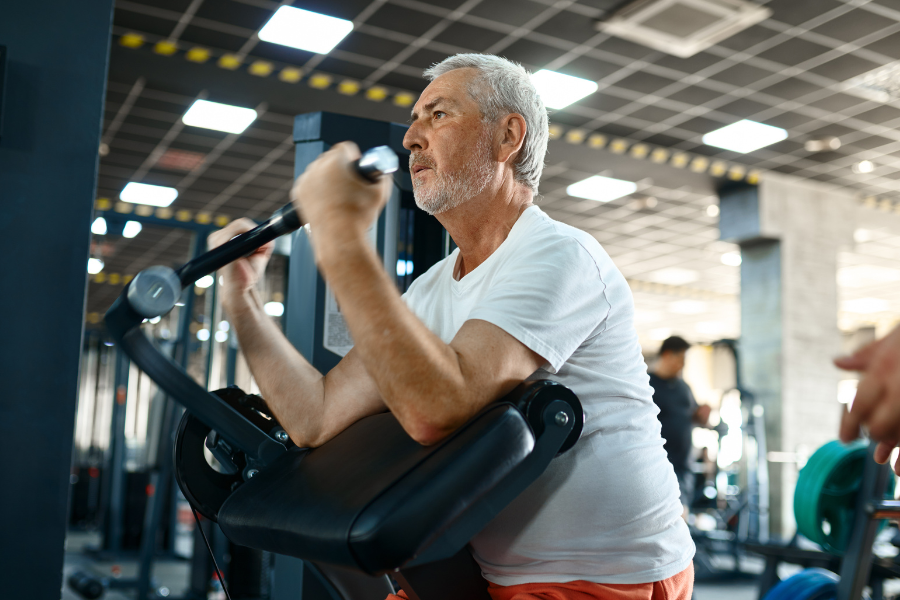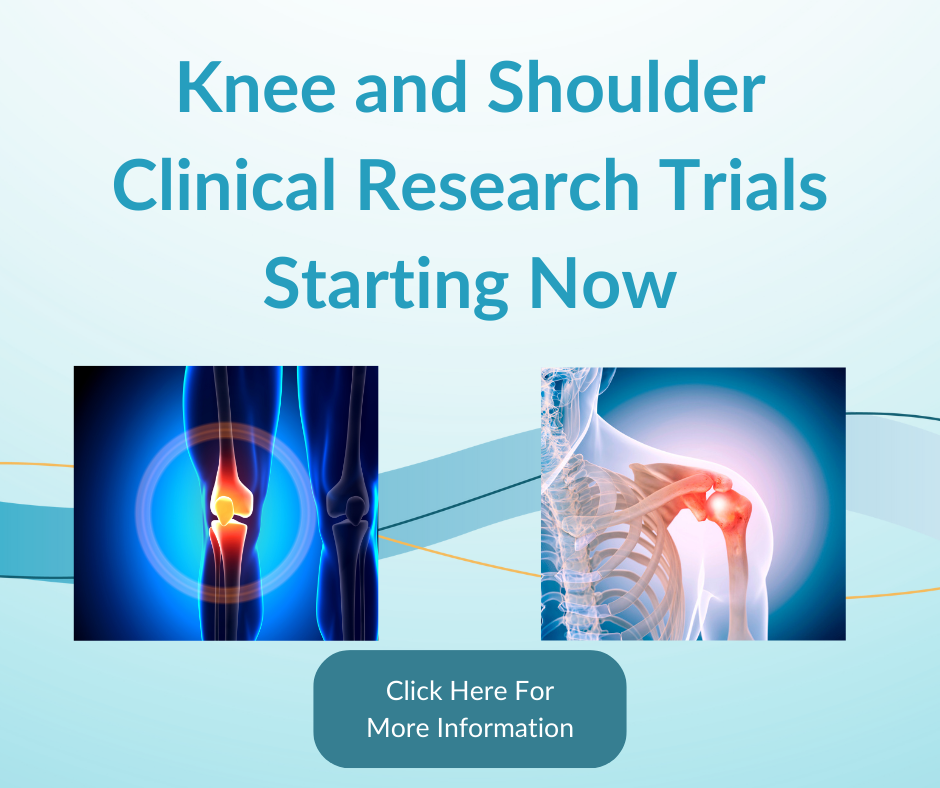Can Exercise Help Ease Arthritis Pain?
 Arthritis is a terribly painful (and painfully common) medical condition that affects joints, particularly as we age. The good news is that regular exercise improves function and mobility while reducing pain. While proper movement and pressure can nourish the cartilage in joints, inactivity can increase arthritic pain and worsen the condition. Lack of exercise causes stiff joints that are malnourished, unlubricated and dry.
Arthritis is a terribly painful (and painfully common) medical condition that affects joints, particularly as we age. The good news is that regular exercise improves function and mobility while reducing pain. While proper movement and pressure can nourish the cartilage in joints, inactivity can increase arthritic pain and worsen the condition. Lack of exercise causes stiff joints that are malnourished, unlubricated and dry.
How can exercise improve my health without hurting my joints?
Whichever type of exercise you’re performing, you may feel some discomfort at first, but you should start to feel better within a few minutes. If your discomfort doesn’t quickly subside, it may be a warning sign to take it easy. Start with simple, gentle stretches and gradually progress to low-impact activities.
What type of exercises can benefit my arthritis?
Research has shown that regular moderate activity helps prevent the progression of arthritis and improves overall fitness. Fear of pain may cause you to avoid exercise, but it’s important to remember that such inactivity will likely lead to further arthritic pain. People with arthritis should aim to exercise 30 minutes a day, 5 days a week. Short sessions of exercise throughout the day provide great health benefits, so consider three 10-minute exercises throughout the day if a half-hour workout seems daunting.
Recommended exercises for arthritis include:
- Stretching
- Yoga
- Tai Chi
- Light Weight Lifting
- Walking
- Cycling
- Swimming
- Water Aerobics
- Range-of-motion exercises
Since joint health is a “use it or lose it” proposition, joint exercises should be part of your regular exercise routine. Common exercises that build range-of-motion include gently straightening and bending the joints with simple stretches. Try these stretches with careful control and proceed only as far as is comfortable. Joints should be stretched gently until normal or near-normal range-of-motion is attained. Range-of-motion exercises not only benefit your joints, they act as important warm-ups for more rigorous strength training and aerobic exercises.
- Strength training – Strength training exercises known for their muscle-building benefits can also help protect your joints. Weight training – under the supervision of a qualified professional – can help you maintain or increase your muscle strength. Remember to rest between workouts and take an extra day if your joints are swollen or painful.
- Aerobic exercises – Low-impact aerobic exercises that improve cardiovascular health and help with weight management are also great for managing arthritis pain. Low-impact exercises include walking, cycling, swimming and using exercise equipment such as elliptical machines.
How to Manage Arthritis Pain
Arthritis is one of the most debilitating conditions that affects billions of individuals worldwide. As of 2015, 54.4 million adults across the United States alone have been professionally diagnosed with arthritis. Of these individuals, 49.6% were 65 and older, a percentage that is expected to continue growing in the next 25 years.
What many do not know, however, is that arthritis pain is 100% manageable if approached with the right knowledge and state of mind. If you have recently been diagnosed with arthritis, the following do’s and don’ts of arthritis pain should serve as a good starting point for living a stress-free life.
Dos and Don’ts of Easing Arthritis Pain?
 Do:
Do:
- Learn as much as possible about your condition, including the type of arthritis and extent of joint damage (if any).
- Plan your pain management tactics with your family, friends, and doctor.
- Be honest with your doctor should the pain increase.
- Maintain good posture, whether sitting, standing or walking.
- Maintain a healthy weight to prevent added stress on your joints.
- Perform gentle stretches to move your joints through their full range of motion every day.
- Perform low-impact activities that build muscle and strength without damaging your joints, such as walking, swimming or cycling.
- Balance physical activity with plenty of rest.
- Work with your doctor on a custom medication plan for your distinct symptoms.
- Make good use of heat and cold, such as heating pads, paraffin wax and/or ice packs.
- Consider massage for temporary relief of pain and joint stiffness.
- Consider therapeutic activities for the mind and body, including talk therapy, relaxation exercises or acupuncture.
- What Makes Arthritis Pain Worse?
Don’t:
- Ignore severe pain, as it might indicate joint inflammation or damage that requires daily treatment.
- Engage in activities involving repetitive motion and/or high impact, such as running, jumping or aerobics.
- Overtreat your symptoms with over-the-counter pain medications.
- Smoke tobacco, as it contains toxins that place stress on your connective tissues and aggravate the pain.
- Focus solely on the pain, as arthritis pain sufferers are at a higher risk of depression.
- Develop a negative attitude about your ability to manage the pain, as negative thoughts can only elevate your risk of disability.
How to Treat Arthritis Pain
 Arthritis is a medical condition that causes joint inflammation. Pain and stiffness in the joint are two of the main symptoms of this condition. Arthritis can also cause swelling and a decreased range of motion. This condition can have a negative impact on a person’s quality of life, but the good news is that there are a number of treatments available.
Arthritis is a medical condition that causes joint inflammation. Pain and stiffness in the joint are two of the main symptoms of this condition. Arthritis can also cause swelling and a decreased range of motion. This condition can have a negative impact on a person’s quality of life, but the good news is that there are a number of treatments available.
Below are some of the ways that arthritis can be treated:
Medication
Mild arthritis pain can usually be managed with over-the-counter medications, such as Tylenol. Non-steroidal anti-inflammatory drugs can also be used to manage the pain. There are both prescription and over-the-counter anti-inflammatory drugs. Naproxen and Motrin are examples of these medications. Non-steroidal anti-inflammatory drugs do not come without the risks of side effects. Serious side effects include stomach irritation and increased heart attack risk.
Corticosteroids are another type of medication that can be used to treat arthritis. This class of drugs contains both cortisone and prednisone. Corticosteroids can be taken orally, or they can be injected directly into the affected joint.
Physical Therapy
Physical therapy has been shown to be very effective for treating arthritis. A physical therapist can teach the patient how to perform exercises that improve range of motion. Physical therapy also helps strengthen the muscles that surround the joint.
Yoga or Tai Chi
Both yoga and tai chi place emphasis on performing slow, stretching movements. They can help improve range of motion and flexibility.
Acupuncture
This is a form of therapy that involves inserting needles into certain pressure points on the body in order to alleviate pain. Because acupuncture can help alleviate pain, it can potentially help treat arthritis.
Losing Weight
Obese people are more prone to arthritis because the excess body weight puts more pressure on the joints. That is why losing weight can benefit people who suffer from arthritis. Losing weight will not only alleviate the pain, but it will also improve range of motion. Eating healthy and exercise are the keys to successful weight loss.
Tips to Protect your Joints While you Exercise
 An exercise mantra of the 1980’s used to proclaim, ‘no guts, no glory.’ Now a good approach is ‘train, don’t strain.’ Those of us with arthritis might feel less inclined to exercise, but in fact exercise is crucial for increasing strength, reducing joint pain, and avoiding fatigue. The key is ‘train, don’t strain’ – you don’t need to be a weekend warrior to see real results.
An exercise mantra of the 1980’s used to proclaim, ‘no guts, no glory.’ Now a good approach is ‘train, don’t strain.’ Those of us with arthritis might feel less inclined to exercise, but in fact exercise is crucial for increasing strength, reducing joint pain, and avoiding fatigue. The key is ‘train, don’t strain’ – you don’t need to be a weekend warrior to see real results.
Tips to protect your joints:
- Avoid exercise involving the same groups of muscle two days in a row
- Rest a day between workouts
- Take a rest of at least an extra day or two if your joints are swollen or painful
- Building muscle might require a 3-day a week program, but only 2-days a week is necessary for maintenance
- Keep the impact low – ellipticals, pools and stationary bicycles are your friend
- Go slowly, move gently and apply ice afterwards to reduce joint swelling
- #1 tip – don’t overdo it. Trust your instincts. There’s always tomorrow.
Is there a wellness tool or app that can help me?
If you’re living with arthritis and using doctor-recommended exercises to manage pain, you can track your activity by downloading a mobile fitness app. The Arthritis Foundation developed the “TRACK+REACT” app to help you track your day-to-day activities and improve your overall health. Download the app to start tracking your exercises and reduce the pain caused by your arthritis. Always follow the instructions for exercise machines carefully.
Any exercise is good for you-you don’t need a gym membership
Regular exercise is critical for joint health and arthritis pain management, but you don’t have to join a gym or begin a vigorous fitness regime! Tasks that are already part of your daily routine, such as walking your dog, gardening, or mowing the lawn can help you stay active and reduce arthritis pain. To avoid increased pain, adjust your activity levels as your confidence and abilities grow. Exercise is a healthy and effective way to manage arthritis pain, so you can start to feel like your old self again.
What Exercises Are Good for Hand Arthritis?
People who live with arthritis know the pain, stiffness, and weakness that come with the joint disorder. Arthritic hands can be especially debilitating since humans are almost constantly doing something with their hands.
Certain exercises may help to reduce the pain of arthritis while also working to strengthen the hands. Here are some easy exercises to relieve arthritic pain that you can do almost anywhere.
- Make a Fist – This is a super simple exercise you can do whenever your hands are feeling stiff. Simply hold up one of your hands and slowly bend your fingers to create a closed fist. Make sure not to squeeze your hand too tightly—be gentle! Slowly open your hand again and continue these motions with the other hand.
- Rest Your Hand on a Flat Surface – If you’re feeling arthritic pain in your hands, try resting your hand on a flat surface—perhaps your desk if you’re at work or a tabletop. Place your hand on the surface with your palm facing down and slowly move your thumb from your other fingers. Continue to do the same movements with your others fingers by individually moving them towards your thumb.
- The Thumb Bend – This move makes use of a tabletop too. If arthritis has got your hands feeling sore, try placing the edge of your right hand on a surface with your thumb pointed upward. Try to hold this position for 10 seconds and then move it back towards the other fingers. Repeat these motions with your other hand.
- The Claw Stretch – The move will help increase the range of motion in your hands and fingers in a few simple movements. Begin by stretching your arms and hands out in front of you. Bend the top finger joints downward towards your palms so your hand somewhat resembles a claw. Hold this position for 30 seconds and repeat.
- The Stress Reliever – One of the downsides of arthritis in your hands is not being able to properly grip objects at times. This exercise will not only help relieve pain in your joints, but it can help strengthen your grip and relieve stress as well. This move can be easily executed by using a stress ball or a toy ball and squeezing it 10 times, making sure to hold each squeeze for a few seconds.
What Exercises Are Good for Hip Arthritis?
Those living with osteoarthritis in their hip know the daily struggle of dealing with their pain. Activities you once loved may seem unthinkable and you feel as if you are missing out on your life. While the stiffness, spurs and pain might make exercise seem impossible, this is actually one of the best ways to manage your symptoms. Regularly working out your hip is a great way to decrease your pain and increase your range of motion.
What to Avoid
The number one thing you need to avoid while exercising with hip arthritis is high-impact activities. This can cause your arthritis to worsen over time and even lead to more serious injuries. Hip health will decay over time and your arthritis symptoms will increase.
A high-impact activity is any exercise where both feet leave the ground at the same time. Jump rope and running are two of the most common high-impact activities, but there are many different kinds. Having both feet off the ground adds stress to your knees and hip, worsening your symptoms. Stick to low impact exercises, such as walking and swimming, when dealing with hip arthritis.
Lots of Cardio
Cardio exercises are great not only for your arthritis pain, but overall health. It’s important to not put too much stress on your hip while doing cardio and stick to low-impact exercises. Here are some great, low-impact cardio exercises and activities to help with your hip:
- Elliptical
- Stationary bike
- Swimming
- Tai Chi
- Golf (bonus points for skipping the golf cart!)
- Speed Walking
- Ballroom dancing
- Kayaking
- Strengthen Your Muscles
Strong muscles will not only improve your balance but take much needed pressure off your arthritic hip joints. However, it is important to be careful with your hip so do not perform muscle strengthening exercises more than twice a week. Here are just a few of the best exercises that we recommend relieving your pain:
- Hamstring stretches
- Side leg raise
- Bridges
- Standing hip extension
- Straight leg raises
- Increase Range of Motion
Those suffering with arthritis pain know that lack of mobility can be almost as bad as the pain. Increasing your range of motion will help you regain control of your life and reduce your pain and stiffness. Try some of these exercises to improve your flexibility:
- Hip and lower back stretch
- Double hip rotation
- Front to back leg swings
- Standing squats
- Inner leg stretches
The main thing to remember when exercising is to always listen to your body. If you feel any increased pain or stiffness stop at once as you might be overexerting yourself. The best way to exercise is by gradually increasing your activity during the day and walking whenever you can.
What Exercises are Good for Knee Arthritis?
When you have knee arthritis, the simplest daily tasks can seem impossible. Activities that you once loved to become too painful to enjoy, and you feel as though you are missing out on life.
While you might believe that medication is the only remedy, daily exercise can lessen and even relieve the pain and swelling in your knee due to arthritis. Here at Coastal Orthopedics, we know that you have better things to do with your life than worry about pain in your knee caused by arthritis. Here are just a few simple exercises that will help keep you pain free.
- Stretching – If you like to work out at home, stretching can be an easy way to exercise your knee. Quadricep stretches, hamstring stretches, and forward bends are just some examples of great options for patients with knee arthritis. Talk to a Coastal Orthopedics physician to find out what stretches could work best for you.
- Yoga – Yoga helps your arthritis in much of the same ways as stretching. It also allows you to focus on your breathing which can help with stiffness and tension. However, it is important to only do yoga with an instructor who has experience working with knee arthritis, as some yoga positions can actually make your knee worse.
- Aquatic Aerobics – Water exercises are a favorite among those living with arthritis. It is a low impact exercise that allows you to fully workout, without putting too much pressure on your knee. The water also increases your body’s temperature, increasing blood circulation.
- Bicycling – Both stationary and outdoor cycling are great ways to work out your arthritic knee. When using a bike, you have less pressure on your knee than running, but you are still exercising your legs.
- Walking – Probably one of the easiest exercises to do, walking has great benefits for those suffering from arthritis in their knee. However, sometimes what’s easiest can be the hardest to find motivation to do, especially when you experience excruciating pain while doing so. That’s why the Arthritis Foundation® has created the Walk with Ease Programâ„ . You can meet up with other arthritis patients three times a week for exercise and support.
Yoga for Arthritis and Joint Pain
Living with arthritis and joint pain can be difficult. Besides dealing with stiffness, swelling and overall pain, you may find it challenging to exercise if you have physical limitations.
Yoga, however, is a great practice that can help you incorporate more exercise into your daily routine while easing your symptoms in the process. Below are three easy yoga poses that can help to ease arthritic and joint pain that you can try right now.
- Mountain Pose – Mountain pose is a great pose to begin with since it is gentle and often the beginning position for other poses. To start, simply stand with your big toes touching and your heels slightly apart. From here, lift and spread your toes before placing them back down on your mat. As you gain balance and strength, try holding this position for longer increments of time.
- Bridge Pose – Bridge pose is a great move everyone can try, whether they’re a novice yogi or an expert. Not only can this pose help ease arthritic pain, but it can also help improve your posture. To perform this move, start by lying on your back with your arms resting at your side. As you inhale, slowly bend your knees before exhaling. With the palms of your hands on your mat, engage your core and legs to slowly lift your buttocks and lower back off of the ground until your thighs are parallel to the floor. Hold this position for 30 seconds (if you can) and then slowly lower yourself back onto your mat and repeat.
- Sun Salutations – Sun salutations are an easy yoga move that stretches nearly every muscle in the body. Even better, sun salutations are meditative and calming because they connect your movement with your breath. To perform this move, stand with both feet touching and bring your palms together, placing them at your heart. Slowly exhale and raise your arms upward before moving into a backbend, with your arms stretching above your head. Bring your arms forward and bend at the waist, allowing your arms to gently pull your upper body towards your legs. Slowly, bend and extend one leg and go into a deep calf stretch. From here, go into a plank pose before starting the process over again.





